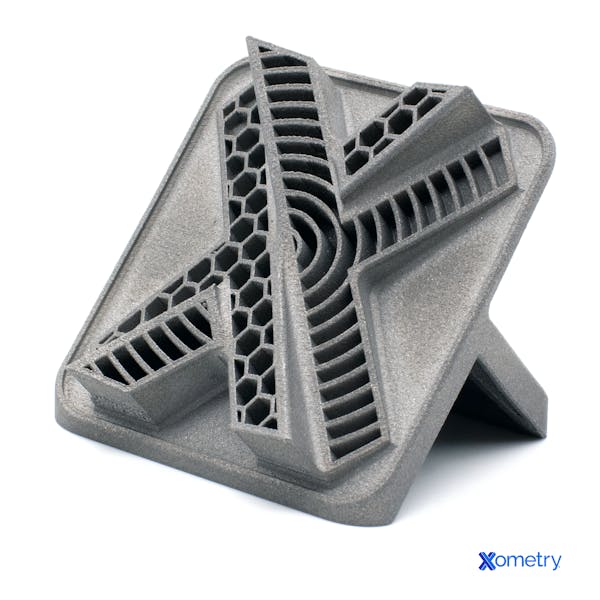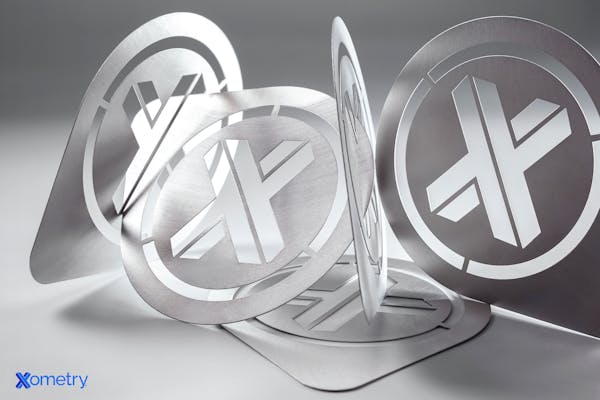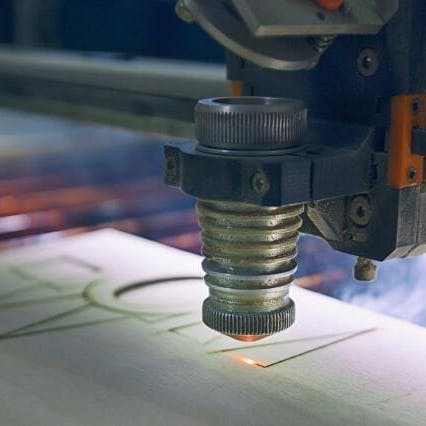Laser cutting and 3D printing are two very popular services we offer at Xometry. Laser cutting uses a high-powered laser beam to cut flat sheets of material, typically metal, into different shapes. With 3D printing, CAD models are sliced into 2D cross-sections and built up one layer at a time until the part is complete. Laser cutting is suited to flat sheet fabrications, whereas 3D printing can produce plastic, or even metal, products of almost any geometry.
Despite being two very different technologies, both are useful in their own rights. In this article, we will cover how 3D printing and laser cutting work, their advantages, disadvantages and the materials they can work in. Let's dig in!
3D Printing Definition and Comparison to Laser Cutting
As mentioned in the intro, 3D printing is a process used to build up parts one layer at a time via the addition of material (plastic or metal). Its first documented iterations can be traced back to the early 1980s in Japan. Hideo Kodama developed a rapid prototyping system using a photosensitive resin polymerized by UV light, what we now know as the SLA 3D printing processs. Over the years, many other 3D printing technologies Xometry offers, such as FDM, SLS, DMLS, PolyJet, and more, have been developed. FDM extrudes material through a nozzle and lays it down onto a build plate and then onto each subsequent layer. SLS and DMLS, on the other hand, use powerful lasers to sinter or fuse particles of powdered material one slice at a time until the part is complete. No matter the method used, all 3D printing processes are considered additive technologies, unlike laser cutting, which cuts parts out from existing sheet stock, making it a subtractive process. For more information on additive manufacturing, see our guide on what is 3D printing.
Xometry offers the ability to custom 3D print parts for your needs. A metal print made through Xometry's DMLS 3D printing service can be seen in the image below:

What are the Advantages of 3D Printing Compared to Laser Cutting?
Listed below are some advantages of 3D printing over laser cutting:
- 3D printing can produce complex 3-dimensional parts out of both plastic and metal. Laser cutting can only create simple 2-dimensional parts.
- 3D printing has access to a wide range of materials from thermoplastic elastomers to Inconel. Many plastics and some metals like copper and aluminum are generally not suited to laser cutting.
What are the Disadvantages of 3D Printing Compared to Laser Cutting?
Listed below are some disadvantages of 3D printing over laser cutting:
- 3D printing is not well suited to creating large flat parts. This is because 3D printer flat surface areas are generally smaller. Removing thin, flat metal parts from a 3D printer bed will result in them being deformed or damaged. Metal printed parts often need to be cut off from the build plate.
- Producing metal parts with 3D printing is significantly more expensive than laser cutting. Ultimately it is more costly to produce metal powder for 3D printing than it is to produce sheet metal.
Laser Cutting Definition and Comparison to 3D Printing
Laser cutting refers to the process of using high-powered CO2, direct diode, or fiber lasers to cut out flat shapes from stock sheet materials. Laser cutting heads move along X and Y axes, making it a two-dimensional process. The Z direction, or depth of a part, is dependent on the thickness of the material being cut. The technology was invented in the 1960s. One of the first laser cutting machines was created by the Western Electric Engineering Research Center in 1965.
Laser cutters can typically cut metal sheets with thicknesses from a few millimeters up to as much as 25mm. Parts with a thicker requirement are possible with a decrease in cut quality and an increase in cut time. Laser cutters can cut out shapes in a few seconds, making them suitable for producing multiple quantities or multiple components in a short period of time. Laser cutting is widely used in the manufacturing industry and is often used to cut out flat patterns for sheet-metal bending, a process that Xometry can also help you with. To learn more about laser cutters , see our guide on What is a Laser Cutter.
Below is an image of some aluminum sheet metal parts manufactured with Xometry's online laser cutting service:

What are the Advantages of Laser Cutting Compared to 3D Printing?
Listed below are some advantages of laser cutting over 3D printing:
- Laser cutting metal is one of the cheapest methods of metal fabrication. The high production capacity and relatively automated process make the cost per kg much lower than metal 3D printing, for example.
- Laser cutting can process far more material per day than 3D printing.
What are the Disadvantages of Laser Cutting Compared to 3D Printing?
Listed below are some disadvantages of laser cutting over 3D printing:
- Laser cutting can only produce parts with 2-dimensional shapes. 3D printing can produce more-complex 3D components in one step. Laser-cut parts need additional steps – like sheet metal bending and welding – to create complex pieces.
- Not all materials can be laser cut. Some plastics, like ABS, are not well suited to laser cutting as they will melt and deform. Metals like copper and aluminum are also difficult to laser cut. 3D printers, on the other hand, can use these materials and many more.
| Attributes | 3D Printing | Laser Cutting |
|---|---|---|
Attributes Machine cost | 3D Printing $250 to $350,000+ | Laser Cutting $1,000 to $45,000+ |
Attributes High production rate | 3D Printing No | Laser Cutting Yes |
Attributes Uses laser energy source | 3D Printing Yes (SLS, DMLS) | Laser Cutting Yes |
Attributes Can produce sheet metal parts | 3D Printing No | Laser Cutting Yes |
Attributes Can produce complex 3D parts without additional steps | 3D Printing Yes | Laser Cutting No |
Attributes Typical bed size | 3D Printing 600 x 600 x 600 mm | Laser Cutting Standard sheet metal stock size (2.4 m x 1.2 m) |
Laser cutting is a low-cost high-production-volume technology, whereas 3D printing is a low-volume and high-cost technology. Laser cutting is suited to simple 2D parts, whereas 3D printing is best suited to complex 3D parts.
3D Printing vs. Laser Cutting: Lead Cost Comparison
Laser cutting is one of the cheapest metal processing technologies. This is due to its relatively low cost of sheet stock and the high production rate. 3D printing can be cheap if it is used to print small plastic components. However, the cost can quickly escalate with increased product size and more advanced materials like stainless steel or titanium.
3D Printing vs. Laser Cutting: Speed Comparison
Laser cutting is a very fast process. It can produce sheet metal blanks in a few seconds; 3D printing can take many hours to produce a small plastic or metal part.
3D Printing vs. Laser Cutting: Volume Comparison
Laser cutting is a high-production-volume technology. It can cut many tons of simple 2-dimensional parts per month. 3D printing is a slow, low-volume-production technology. It is more suited to complex 3-dimensional parts for advanced applications.
3D Printing vs. Laser Cutting: Materials Comparison
Laser cutting can be used to cut metal, wood, plastic, ceramics, etc. 3D printing, on the other hand, can produce parts in almost any plastic and a wide range of metals. Wood-filled plastics are also possible. 3D printing can also create multi-material parts in one step. As such 3D printing has a wider range of available materials.
Common FAQs About 3D Printing and Laser Cutting
What are the Mutual Alternatives to 3D Printing and Laser Cutting?
3D printing and laser cutting are completely different technologies, designed with different applications in mind. However, the below technology can be loosely described as a mutual alternative:
- Sheet Lamination: Sheet lamination is an additive technology that works by adding multiple layers of sheet stock on top of each other. These are then fused using heat and pressure. Its purpose is to produce parts with near-net shapes that can then be post-processed with subtractive technologies. The sheets can also be laser cut to remove any excess material to more closely match the net part shape.
What are the Similarities Between 3D Printing and Laser Cutting?
Listed below are some similarities when comparing 3D printing with laser cutting:
- Laser cutting machines and SLS, DMLS, and SLM 3D printers make use of lasers as their energy source. 3D printers use lasers to fuse metal powders, whereas laser cutters use lasers to cut through relatively thin sheets and plate metal.
- Laser cutters and metal 3D printers can create parts with a wide range of metals. As such, both technologies can produce parts for real-world engineering applications.
What are the Other Comparisons for 3D Printing Besides Laser Cutting?
Listed below is an alternative to 3D printing:
- 3D Printing vs. CNC machining: CNC machines can produce complex 3-dimensional parts out of plastics and metal. A CNC machine is also a mature technology that is cheaper than 3D printing, especially when it comes to metal parts.
What are the Other Comparisons for Laser Cutting Besides 3D Printing?
Listed below is an alternative to laser cutting:
- Laser Cutting vs. Waterjet Cutting: Waterjet cutting is another technology specifically designed to cut sheet or plate material into 2-dimensional shapes. Waterjet cutting uses a high-pressure stream of abrasive-filled water to cut through the material. Waterjet cutting can cut a wide range of materials including plastic, metal, and ceramics.
How Xometry Can Help
Whether you are looking for 3D printing or laser cutting to create custom metal or plastic parts, Xometry has the solutions to fit your project's needs! When it comes to comparing costs between these processes or many of the other services we offer, getting a quote is simple and quick, thanks to the Xometry Instant Quoting Engine®. Get started by uploading your CAD files, select the process and materials your interested in, and get quotes instantly!
Disclaimer
The content appearing on this webpage is for informational purposes only. Xometry makes no representation or warranty of any kind, be it expressed or implied, as to the accuracy, completeness, or validity of the information. Any performance parameters, geometric tolerances, specific design features, quality and types of materials, or processes should not be inferred to represent what will be delivered by third-party suppliers or manufacturers through Xometry’s network. Buyers seeking quotes for parts are responsible for defining the specific requirements for those parts. Please refer to our terms and conditions for more information.

